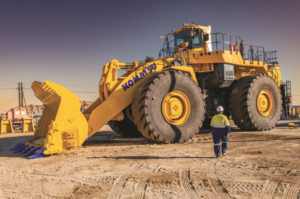Rössing Uranium in June 2023 released its 2022 Sustainability and Performance Report. Managing Director Johan Coetzee said the year was a busy one, with a major focus being on finalising the Life-of-Mine Extension (LoME) feasibility study which led to a positive investment decision in February 2023. Phase 4 of the Rössing Uranium mine near Swakopmund in Namibia will be fully operational in 2027 following a 13-year contract mining agreement signed in May this year with Beifang Mining Technology Services.
During 2022, Rӧssing had been operating on an approved LoM plan to 2026, but completed a bankable feasibility study for a Life of Mine extension to 2036. This will be achieved with a further pushback of the existing SJ Pit (Phase 4), fully utilising the 15-year mining licence granted by the Ministry of Mines and Energy in 2021. The objective of the LoME Feasibility Study was to evaluate and document the technical, practical, and economic feasibility to extend the LoM beyond 2026 and issue a Feasibility Study Report to inform the positive investment decision by the Rössing Board of Directors. The plan is the lowest cost extension option available and will benefit from leveraging off the existing processing and infrastructure facilities.
The project requires deeper mining of the same SJ ore-body through a north-eastern extension of the current pit (Phase 4 pushback) to supply the existing process plant with sufficient ore until the end of 2036 at current throughput rates of 9.2 Mt/y. There is a need to proceed with this pre-strip as soon as possible (2024) to gain access to the ore in Phase 4 before the current ore supply from Phase 2/3 is depleted. An extension of the tailings storage facility footprint is also required to accommodate the additional 92 Mt of tailings, which must be dewatered to a higher density (thickened tailings). In terms of the mine layout, haul road 19 ramp was decommissioned in the early part of 2022. This was a landmark change that shows that the open pit is transitioning into the bottom benches. All open pit ramps are now on the north side of the pit, which reaches about 390 m depth.
The operation was Namibia’s first commercial uranium mine started production in 1976. Despite a formal Life of Mine of 2025, the previous majority shareholder, Rio Tinto, was considering early closure in January 2020. The 2019 sale of Rio Tinto’s majority shareholding to China National Uranium Corporation (CNUC), created a limited duration preferential offtake agreement at subsidised prices and at a premium to production cost, assuring a positive cash flow and continued operation.
Looking again at last year, a highlight for Rössing in 2022 was the commissioning of the mine’s new water reservoirs at a cost of N$100 million. These reservoirs provide an additional 60,000 cubic metres of storage capacity, enabling it to continue operating during periods of high sulphur bloom in the Atlantic ocean, resulting in fresh water supply interruptions due to the stoppage of the Orano desalination plant during these periods.
The mine’s production in 2022 was lower when compared to 2021. A total of 16.6 Mt was mined, compared to 20.7 Mt in 2021, with waste and low-grade ore totalling 7.4 Mt. The lower mining volume was due to the stripping ratio of waste to ore reducing as operations move deeper into the pit. 9 Mt of ore was milled, compared to 9.6 Mt milled in 2021. A total of 2,659 t uranium oxide was produced, compared to 2,882 t in 2021.
The mine currently uses a fleet of Komatsu 730E 180 t class trucks which run under trolley assist for the part of the main haul road. Benches are 15 m but in some areas double benching ie 30 m is possible. The mine employs two Cat 994 wheel loaders (FE15 and FE16) which supplement the main loading fleet of four Komatsu PC5500 face shovels and are primarily used to re-handle ore from the ROM stockpiles to feed the two primary gyratory crushers with sufficient material of the correct blend. Two loading units are required to achieve the re-handle tonnes and at times of poor FEL availability, one of the face shovels is moved to the ROM stockpiles to secure the feed to the crushers which reduce the material to – 165 mm. Recently a new Komatsu WA1200-6 wheel loader has been procured, being delivered to site at the end of December 2022 and has just entered service. In fleet management, the mine has just upgraded its Modular Mining DISPATCH FMS to the latest version.
Rössing Uranium’s new Komatsu WA1200-6

The operation also hails ongoing success from its GroundProbe SSR radar monitoring system with four potentially catastrophic falls of ground properly managed in 2022 without risking people or equipment. The geotechnical team was head-on with guidance and was able to forewarn the operations teams about the impending rockfalls so they could block access to and carefully stabilise the affected areas. Rössing has two units – and acquired SSR114 in 2010 and SSR226 in 2014. The two radars have operated beyond the seven-year lifespan of radar units. These radars are part of the series 1 generation technology of the supplier as compared to the series 3 GroundProbe has recently released. This meant the SSRs the company was using had aged and the relevant software has gone beyond the support of these radars. Some of the critical spare parts on the radar units have become obsolete and unavailable in the market, which made it economically challenging.
Mining Operations, supported by the Projects department, embarked on a project to replace the outdated SSRs to ensure undisrupted monitoring of the south slope and ensure that there is redundancy monitoring to the critical areas (south slope) should one radar become faulty. In addition, the replacement was necessary to ensure adequate management of slope stabilities around the pit. SSR114 was fully replaced and commissioned in July 2022 and this was just before the grace period of software support for this specific radar unit could expire, on 30 August 2022. The SSR226’s support was set to expire on August 30 2023, and this radar has now also been replaced.
Also notable for 2022 was the introduction of electronic blasting technology for pit-limit blasting. This change allows the mine to decrease the amount of energy going into the final pit walls, which helps maintain the long-term stability of the open pit. The technology has since been adopted for all limit blasting at Rössing Uranium.
Rössing contributed approximately 4.4% to world primary production during 2022, with Namibia now being the 3rd largest primary producer of U3O8 globally, after Kazakhstan, (which continues to dominate the market from a supply side), and Canada. No fatalities, permanent disability injuries or significant process safety incidents were recorded in 2022. The All Injury Frequency Rate (AIFR) of 0.43 was lower than the target of 0.48, underlining a commitment to achieving zero harm. The report states: “We were able to achieve this performance safely and efficiently through the commitment and hard work of our own employees, as well as the support from the contractors that are delivering services to us.”




